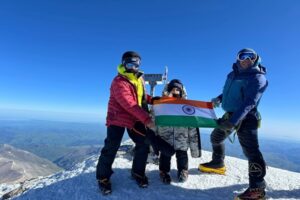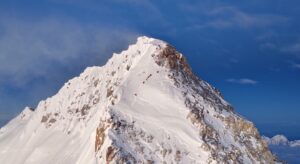While the COVID-19 outbreak ravages both Everest Base Camp and the entire Khumbu Valley, some teams seem to be living in an alternate reality.
Yesterday, several groups felt good enough to hold a party with live music, as if COVID didn’t exist. Pop singer Mike Posner, currently climbing with Jon Kedrowski, sang in a pre-summit push gathering, which included multiple teams.
Nirmal Purja and his partners Mingma David and Gelje Sherpa hurried to share the event on social media. Mingma G, back from Camp 4 after failing to reach the summit with his Imagine Nepal team, also attended. Chhang Dawa Sherpa of Seven Summit Treks didn’t want to miss it, either. Blind to the optics, many of them shared videos of the jam session on Instagram. As just one example, here is Purja’s:
For Purja, who projects messages of leadership, and Seven Summit Treks with over 100 clients on the mountain, such willfully careless behavior is hard to fathom. Both have COVID victims in their ranks. Purja had Steve Davis evacuated some weeks ago, and Tashi Sherpa told CNN that SST had had at least 30 people flown out with the disease!
The party-goers included several newcomers from Dhaulagiri Base Camp, where COVID decimated the climbing teams. Cases at Dhaulagiri started after the climbers previously on Annapurna arrived after days of celebrating their Annapurna triumph in Pokhara. No post-celebratory COVID tests occurred. Now, some of them have moved to Everest without waiting at least five days (the average time for the virus to show up on tests).
In Kathmandu, Sophie Lavaud had her own birthday party, sans dancing. She was one of those who caught COVID at Dhaulagiri. She is now “recovering slowly, still a strong cough but getting better every day,” she says.

Sophie Lavaud, on the mend from COVID, celebrates a not-so-happy birthday in Kathmandu. Photo: Sophie Lavaud
Jonatan Garcia also confirmed to ExplorersWeb that while he was tested and kept quarantine in Kathmandu, others took no precautions or tests before arriving at Dhaulagiri Base Camp.
In a normal year, parties are normal.
In a normal year, such parties are normal. But this is not a normal year. Nor was this the only party held in Base Camp. However, it is the one clearly involving several teams, whose members had close contact with COVID cases in the last few days.
The overall situation has so spiraled out of control that the Chinese climbers surprisingly fled even from the North Side. Other teams, such as Lukas Furtenbach’s, felt forced to leave the mountain.
Furtenbach shared his thoughts on canceling the expedition in a long post on social media. Now that he is away from Base Camp, he is hiding nothing.
“We tried to do everything right. As right as it can get, running an expedition during a pandemic. We had our safety protocols, we were [climbing] isolated, we were isolated in Base Camp, and we did extensive testing. We were even more careful when the COVID outbreak in Base Camp started, when we heard from the first teams with COVID cases, the government denying these cases, and other teams still having parties.
A call for mass testing ignored
“I was calling for a mass test in Base Camp. The call was ignored. We tested even more, while others never started to test or stopped testing after too many Sherpas or members tested positive.”

Lukas Furtenbach testing an expedition member. Photo: Furtenbach Adventures
Crucially, Furtenbach warned what can happen when teams start moving up the mountain:
“If we send people up the mountain, clients or Sherpas or guides, who feel well and test negative, they can still be infected and get sick the next day, or after two days, in C3 or C4. COVID is a pulmonary virus. Getting symptomatic in C3 or higher, with fever and breathing problems, can be a problem. A real severe problem, like dying. Because helicopters can’t fly up there.
“I could not live with being responsible for the death of a Sherpa or client because of a COVID infection that became problematic during our summit push. We all know that there is a massive outbreak in Base Camp. All teams. Pilots know, insurance [companies] know, HRA [Himalayan Rescue Association] knows. Still sending people up is negligent from a legal point of view and inhuman from a moral point of view. Our team doctor told me this morning, if we send people up, she is out. Our guides agreed. I agreed. We all did not sleep for two nights. Now we feel relieved. Devastated, but relieved. Because at least our expedition will not be responsible for COVID cases high up on the mountain.”

A member of Mountain Professionals checks his O2 system before setting off toward the summit of Everest. Photo: Mountain Professionals
Meanwhile, another summit push begins
Some teams have begun their final push, concerned only about the uncertain weather. Madison Mountaineering checked in today from Camp 2. They still project May 20, 21 and 22 as possible summit days but they are “reassessing the situation daily”. They plan to set off tomorrow.
Alex Abramov (no-O2) and his Russian teammates, whom some climbers cite in relation to BC parties, hope to summit on May 20. SummitClimb is pondering options. Party-goers Kedrowski and Posner are currently hesitating because of the changeable forecast and the high winds at 8,000m.
Meteorologist Michael Fagin of West Coast Weather broke down the uncertain weather for ExplorersWeb: “A major cyclone tracking along the west coast of India this week will not make a direct hit on Everest,” he explained. “But the cyclone will bring bands of cloud toward Everest on May 18 to May 21. Models differ greatly on possible snowfall amounts. A few suggest that we might see up to 10 inches (25cm) of snow for one or more of those days. But some models show no snow for Everest.”

The cyclone along the west coast of India, about to move inland.





